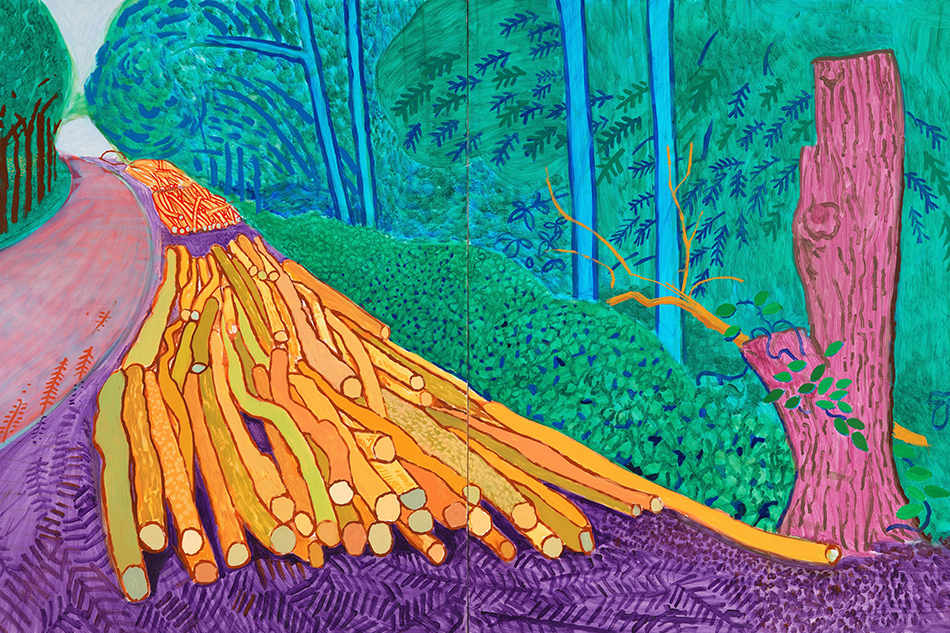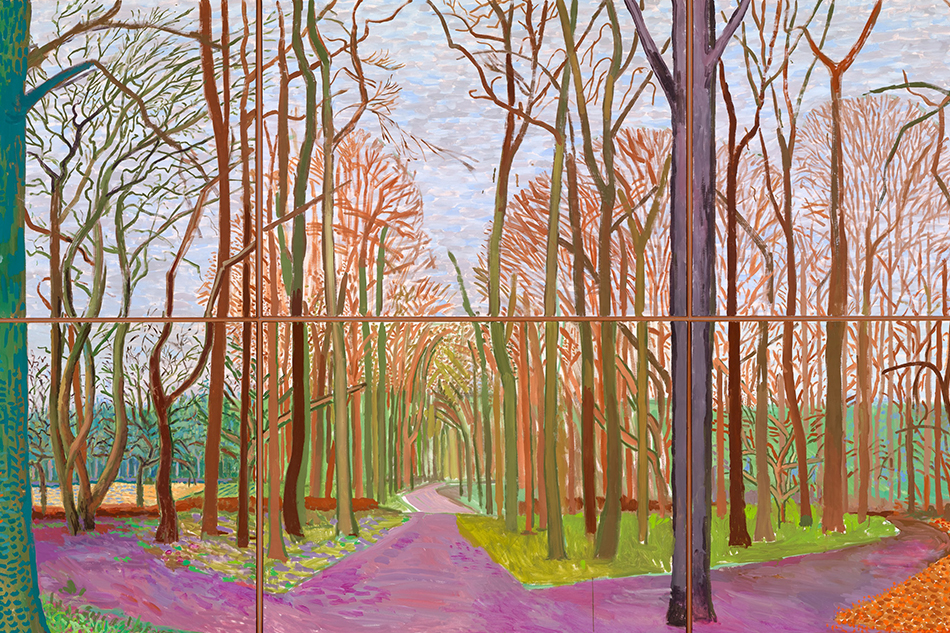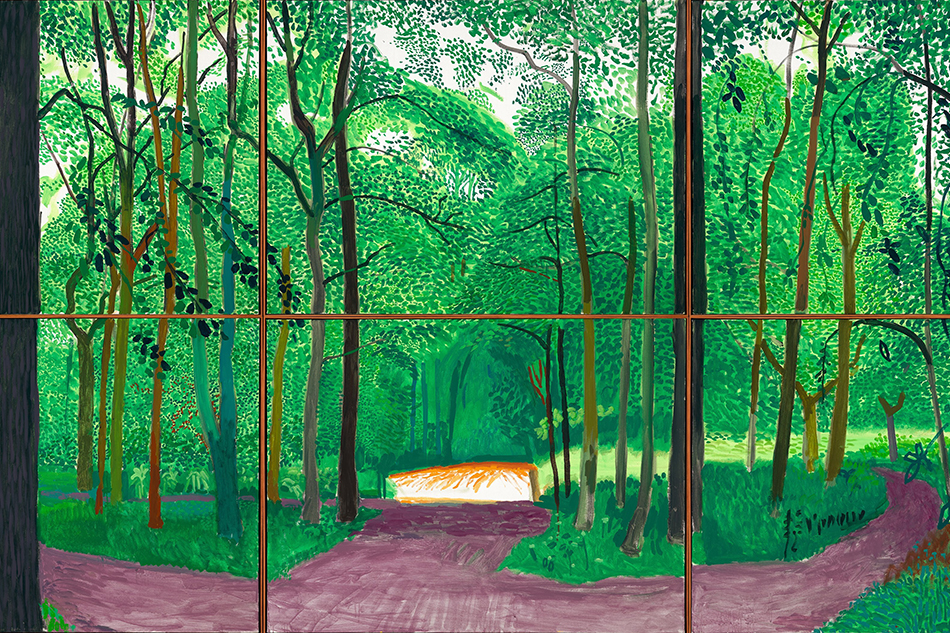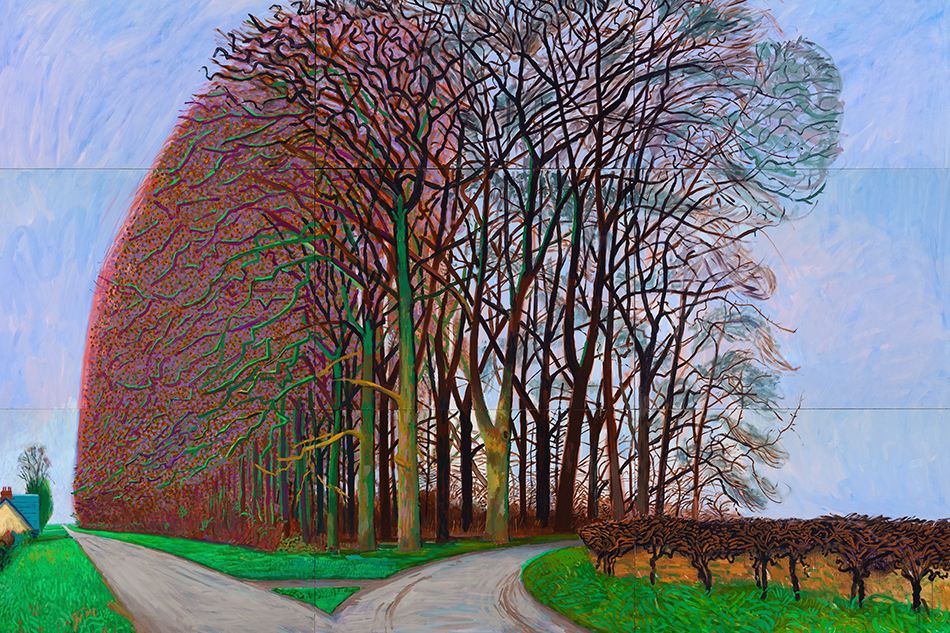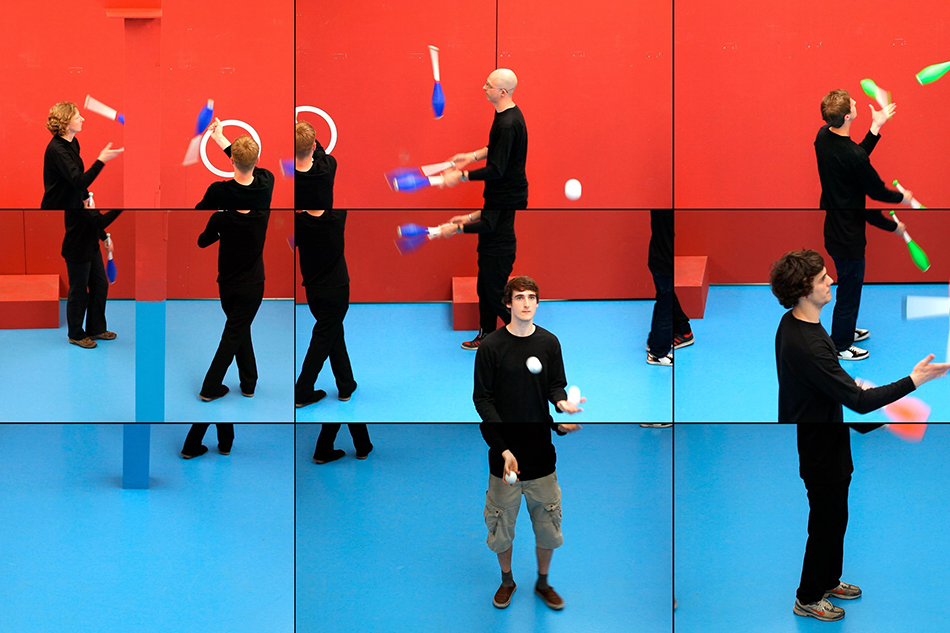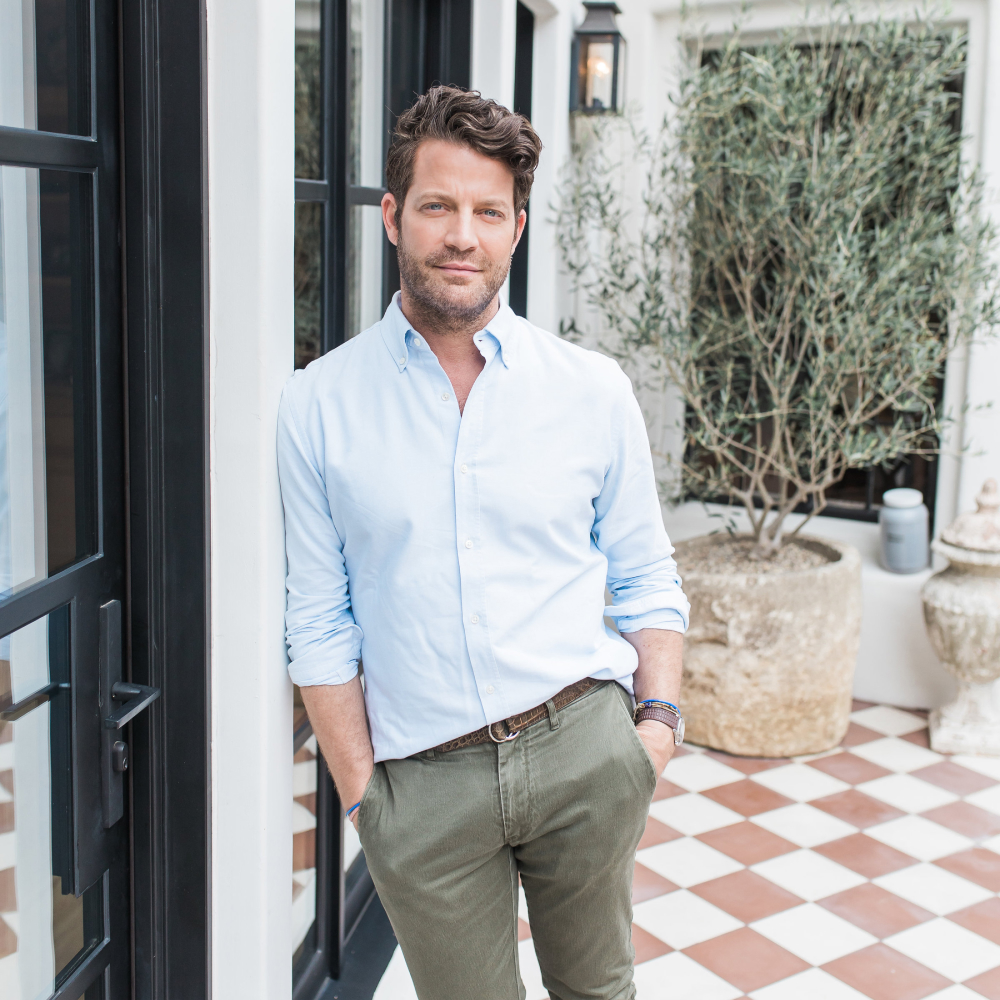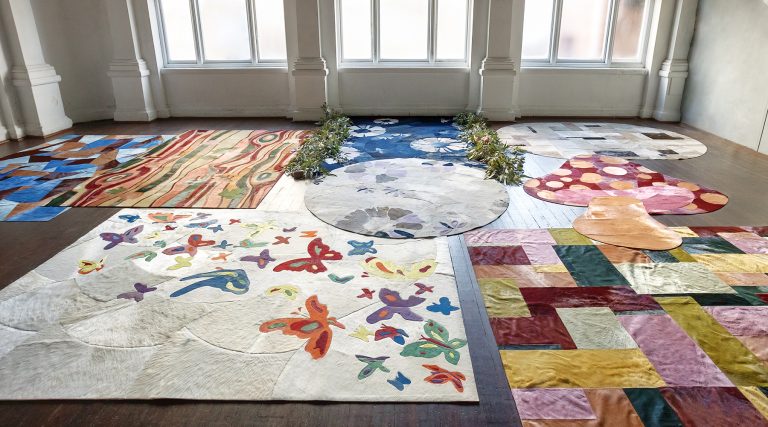
December 4, 2013The de Young features some 300 David Hockneys, including the watercolor Self-Portrait with Red Braces, 2003 (above), and the oil-on-canvas Bridlington Rooftops, October, November, December, 2005 (top). All images photographed by Richard Schmidt and courtesy of the de Young
During a recent lecture at Otis College in Los Angeles, I heard Roberta Smith, the chief art critic of the New York Times, say she was heading on to the de Young Museum in San Francisco to see if she could “learn to love Hockney.” Across town at a dinner party a few nights later, a group of discerning blue-chip collectors told me that they were all flying north just to see David Hockney, whom they called their “favorite artist.”
Such is the art world’s range of reactions to Hockney’s assiduous drawings of his mum and his cohorts; to his oil paintings of himself and his lovers; to his elegant Zen florals; to the smart photo composites of cityscapes; and, yes, to his persona-defining SoCal pools often dotted with nude, round-butted boys. Though no one with eyes could reasonably doubt his mastery over the figure, color and line, for inexplicable reasons, Hockney is an artist you either love or you don’t.
Regardless of your opinion, “David Hockney: A Bigger Exhibition,” at San Francisco’s de Young Museum through January 20, 2014, establishes that, at age 76, Hockney remains an irrepressible and serious creative force. Surveying the past decade of his career in some 300 works, many almost room-scaled, spread over a dizzying 18,000 square feet, the exhibition is the largest in the history of the museum.
Richard Benefield, the show’s curator and the deputy director of the Fine Arts Museums of San Francisco, tells 1stdibs why, when it comes to showcasing Hockney, bigger is indeed better.

Yosemite I, October 16th, 2011, iPad drawing
I notice a slightly different tone here: no pretty boys, no faces of art cognoscenti. A lot of the show feels more contemplative, even Wordsworthian, in the way Hockney almost lovingly considers the forests of Yorkshire and references the felling of its trees by loggers.
I think there’s a different tone, but I’m not sure it’s nostalgic. David says the light in Southern California is ten times the light anywhere else; works made in Yorkshire or Yosemite are moodier just by virtue of climate.
Both in his own body of work and in his 2001 book, Secret Knowledge: Rediscovering the Techniques of the Old Masters, Hockney has always seemed fascinated with state-of-the-art technologies, with how these relate to art history and to the way artists see and depict the world.
In the 1980s, when David did those Polaroid vistas from hundreds of snapshot viewpoints and drawings with the camera lucida, it was not technology for its own sake but a way to remind us that one-point perspective is a tool, not a rule, for art-making, one of many that artists have always used. We do not see or experience the world in the single-frame Cyclops way.

Yosemite II, October 5th, 2011, iPad drawing
Is all this then related to his decision to begin drawing with the iPad?
Yes and no. Hockney has been curious about everything uncharted since grad school. In 2004, after mastering the super hands-on technique of watercolor for two years, he began for the first time in his career to do plein-air work, quickly recording what he saw outdoors. He says that when you are cleaning brushes, applying pigments, letting things dry, you are not observing with full focus. The iPad was just so fast for him, he could work quickly and fluidly.
Some of the iPad works are studies, and some end up as part of stand-alone finished pieces.
When I studied dozens and dozens of his sketchbooks to plan this show with David, I saw that whatever the tool — ballpoint pen, felt-tip marker — he stays with it to the point of mastery. The same happened with the iPad.
You have a pretty high-tech way of showing his sketches.
Yes, we have digital displays of sketchbooks that actually show and turn each page, so you can watch the way he thinks and develops an idea toward a finished work.
“Whatever intensely focused period Hockney spends experimenting with this or that,” says curator Richard Benefield, “he always returns to painting.”

Margaret Hockney, 14 February, 2013, charcoal on paper
He seems to sketch nonstop. Whether it’s with an iPhone or a pencil, he is constantly drawing.
He is a consummate draftsman regardless of the tools. In other words, he always comes back to his roots as a painter. Whatever intensely focused period Hockney spends experimenting with this or that, he always returns to painting. This refined, painterly gift shows in everything. He actually uses technology like a fine artist as well. In the iPad drawings, he is building or layering the digital image back to front like one does in paint. He is layering color, manipulating varying levels of depth.
Can you give an example of this dialogue between the technology and the hand?
In The Arrival of Spring in Woldgate, East Yorkshire in 2011 (twenty eleven), Version 3, he recorded the changing seasons in real time on the iPad, then returned to the studio and, using those on-the-spot digital sketches, envisioned this explosion of spring in a massive thirty-two-panel painting. We show the 12 printed iPad drawings along with the grid of canvases as one work.
Those huge multi-canvas works and the grids of video screens sort of overtake you; you don’t know where to focus, so that you are less looking at them and more walking into them.
That is one of the reasons for the monumentality and for Hockney’s decision to work in composite views via multiple panels; one-point perspective and those kinds of static systems fall apart when you experience these.
Even at this scale, there is a gentleness to much of this work that led me to my romantic fiction of a becalmed Hockney.
You are not altogether wrong. He describes The Arrival of Spring in 2013 (twenty thirteen), which is 25 separate masterful and quite traditional charcoal drawings finished in May, as a single work communicating the transformation from stark winter to the richness of a new season.

A Bigger Message, 2010, oil on canvas
Which brings me to the very eccentric work, A Bigger Message, which depicts figures in biblical garb, and a sort of prophet figure atop this strange, bright mount. Hockney’s close friend, the cultural critic and former New Yorker writer Lawrence Weschler, writes in the catalogue that Hockney’s work in both portraiture and landscape is eventually about the courage to continue to love and live even in the face of trauma. Is this his messianic message?
That work is actually a massive and pretty startling 30-canvas re-working of Claude Lorrain’s The Sermon on the Mount. You could interpret it as Hockney being a prophet, but an artistic one, not necessarily a spiritual one.
What do you mean by that?
I think the work is more about process. The Claude Lorraine was bold because at a time when one-point perspective was equated with skill he handled space very differently, with a receding vanishing point off to the side, not in the center. This loosened organization appealed to David, and so he made his own version.

Self-Portrait with Charlie, 2005, oil on canvas
And that same message comes through again in his so-called “Cubist movies,” where single-screen moving views of a juggler or of changing seasons are combined into one multiscreen, stroboscopic grid capturing change over time.
Again, even though that kind of technology seems 21st century, Hockney’s concerns are sort of classic modern ones. Picasso’s major question was how we see space; Cubism attempted to display multiple perspectives and time in one work of art. The movies are made using as many as 18 separate digital cameras, mounted on a grid and recording the action simultaneously, resulting in a movie with as many as 18 perspectives but always composed with the sensitivity of a fine artist.
You’ve referred to this show as a concentrated look at a 21st-century Hockney.
A decade or so sounds like a narrow time frame, but I should tell you that between 2002 and 2004 he did more than 500 works. Hockney does not use assistants. He produces every work himself. Assistants clean up after him; tech-y assistants help him with software issues, but this is fully hands-on, intense creative output.
An amazingly productive artist.
I am not sure that term covers it. Some artists at his level produce tons of art to make a living, and Hockney makes tons of art to live. He just cannot stop.

